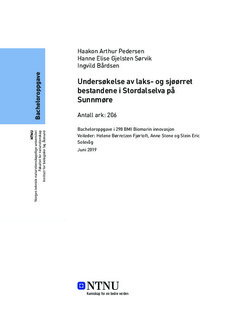| dc.contributor.advisor | Fjørtoft, Helene Børretzen. Stene, Anne. Solevåg, Stein Eric. | |
| dc.contributor.author | Baardsen, Ingvild. Pedersen, Haakon Arthur. Sørvik, Hanne Elise Gjelsten. | |
| dc.date.accessioned | 2019-08-25T14:01:03Z | |
| dc.date.available | 2019-08-25T14:01:03Z | |
| dc.date.issued | 2019 | |
| dc.identifier.uri | http://hdl.handle.net/11250/2610738 | |
| dc.description.abstract | Denne oppgaven handler om bestandsutvikling av laks og sjøørret i ei lokal elv på Sunnmøre. Oppgaven har hovedfokus på elvefasen til fisken. Det ble utført 5 kvalitative intervju, der det ble sett på historien til elva og dagens tilstand. Hovedpunktene som kom fram var fysiske inngrep og høy beskatning. Elva har vært utsatt for både menneskelige og naturlige påvirkninger. Det kan ha ført til tap av yngel i den nederste del av elva og at gytefisken trekker opp i den øverste delen. Det har alltid vært svingninger i fangsten, men den har ikke vært så lav som den er nå på 20 år. På grunnlag av intervjuene ble det utført feltarbeid for å undersøke bunnsubstrat, vegetasjon, skjul og strøm, og om det var forskjell på øvre og nedre del av elva.
Fangststatistikk og intervju viser at sjøørreten nærmest er forsvunnet fra elva. Basert på feltarbeid er konklusjonen at fysiske inngrep i nedre del, og i sidebekker er en viktig grunn til tap av habitat for yngel, og gyteområde for laks og sjøørret. Det har vært fysiske inngrep i Stordalselva som terskelbygging og fjerning av vegetasjon. I enkelte soner blir det foreslått å fjerne terskler til fordel for utlegging av steiner, utlegg og planting av trær, og kulpetrapp for sjøørret. Etter tiltakene er utført kan en starte kultivering, ettersom fysiske inngrep svekker bestanden i disse områdene. Kultivering skal så stoppes når yngeltettheten er god nok. | |
| dc.description.abstract | This bachelor thesis is about the decline of the salmon and seatrout population in a river located at Sunnmøre, Western Norway. Our focus has been on the salmon and seatrout populations with emphasis on the river phase. Five qualitative interviews were conducted, and information gathered here, is both historical and present. Important points from our interviews are high taxation and alteration of the river outline. Human and environmental impacts have shaped the river and there have always been variations in the salmon and seatrout population. The populations are now at its lowest in 20 years. Loss of salmon fry in the lower parts of the river and spawning salmon moving all the way to the uppermost parts, are also key points from our interviews. During our fieldwork variables such as water current, vegetation, hiding spots and gravel size were examined.
Interviews and catch statistics show shortage of seatrout in the river. Based on our fieldwork the conclusion is that alteration of side streams and alteration of the lower parts of the river is the reason why fry, natural habitats and seatrout are gone. The construction of river thresholds and removing of natural vegetation concludes this. Suggestions are made to remove the river thresholds and instead place boulders at strategic places. Reforestation and construction of a pool and weir fishway is also suggested. Cultivation is advised after the changes mentioned above are made. The areas where cultivation should take place would be in relation to where the alterations are already made to the river. When the density of fry is abundant, cultivation should come to an end. | |
| dc.language | nob | |
| dc.publisher | NTNU | |
| dc.title | Undersøkelse av laks- og sjøørretbestandene i Stordalselva på Sunnmøre | |
| dc.type | Bachelor thesis | |
